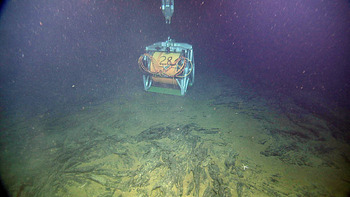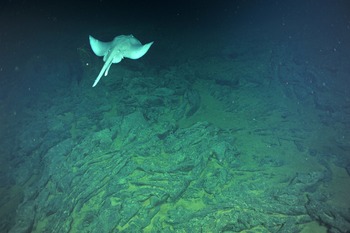On July 15, we completed installation of 15,364 feet (4683 meters) of fiber-optic extension cable on the summit of Axial Seamount from Primary Node 3B to a central site in the caldera at a water depth of ~ 5000 feet beneath the ocean’s surface. With this much wire, the Remotely Operated Cable Laying System (ROCLS) weighed over 6000 lbs and was too heavy to latch into the underbelly of the ROV ROPOS. Therefore, installation required a rare "two wires in the water" operation: ROCLS was lowered into the water by a winch on the starboard side of the R/V Thompson, and ROPOS was then deployed over the port side. This operation takes a lot of skill because of the possibility of entangling the two wires, but it is an operation that the ROPOS team is skilled at.
During a very careful "dance" between the winch operator on the R/V Thompson, the ROPOS pilot and navigator, and ROCLS and ROPOS, the ROV acquired ROCLS on its forward-looking sonar, and then drove slowly towards ROCLS to get a direct visual image with its high-definition camera as both systems slowly descended together into the deep sea.
Once near bottom, the ROPOS pilot found a safe, flat place to set ROCLS on the seafloor. The pilot then gave the command to the winch operator to play out 3 more meters of cable and ROCLS ever so gently touched bottom, with a huge sigh of relief from both the ROPOS team and the science and engineering team. An acoustic signal was then sent to an acoustic release on the ship’s wire attached to ROCLS. The release activated and the ship’s wire was brought to the surface.
Following this event, ROPOS latched into ROCLS (the cable weighs much less in water) and began a several-hour cable-laying operation across the seafloor of the volcano. In the early morning hours, the cable was successfully installed and now awaits follow-on testing during Leg 3 of this expedition.




